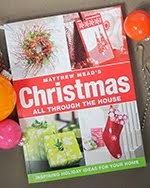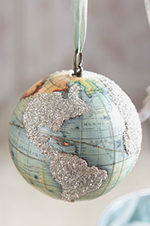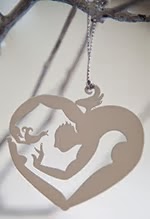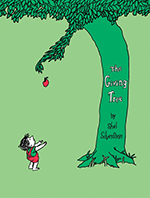AT HALLOWEEN, the usual distinctions between the living and the dead, children and adults, fun and fear are mysteriously blurred. The magic of the season lies in the progression of summer to fall and the onward march to winter. Autumnal colors brighten the landscape with a blaze of color, but eventually turn brown and fall to the ground to nourish the soil. It's all part of the continuous circle of life and death with the promise of rebirth in the coming spring. The Halloween tree is a recent phenomenon and is fast becoming a holiday fixture. It's fun to transform a traditional Winter/Christmas concept.
THIS HALLOWEEN treat tree (above) is made of black crimped wire formed into a trunk with spiked branches creating a spindly silhouette. It is decorated with large metal cones painted to resemble candy corn which are filled with Halloween candy. Similarly, the first modern Christmas trees were hung with fruits, nuts, cookies and pastries. Blown glass ravens with black feather tails perch precariously and glittery wire spiders hang and crawl about—to represent the circle of life and death and pay homage to the natural world. Ravens are incredibly intelligent birds and have the ability to mimic many sounds. Because of this, they are considered wise and to possess powers of prophesy. A small autumnal tableau of pumpkins and gourds are at the base of the tree and Halloween candy is scattered about. The two pumpkins below the base are carved with a folk art tree of life and a black cat, it's back arched in classic Halloween style. The metal crow to the left is pecking at a bowl of candy treats. "Happy Halloween!" letters are strung together behind, along with a witch flying across the moon.
 THE MOST CREATIVE public display of an autumnal tree I've seen was a fifty-foot tall pumpkin tree artfully composed with vines and artificial pumpkins of every shape and size. It appeared at Stone Mountain Park in the Crossroads area a few years back. I went back this year expecting to get pictures of a similar tree, but it wasn't to be found. Rarely do I see a commercially decorated tree of this size with such a magical natural-looking quality.
THE MOST CREATIVE public display of an autumnal tree I've seen was a fifty-foot tall pumpkin tree artfully composed with vines and artificial pumpkins of every shape and size. It appeared at Stone Mountain Park in the Crossroads area a few years back. I went back this year expecting to get pictures of a similar tree, but it wasn't to be found. Rarely do I see a commercially decorated tree of this size with such a magical natural-looking quality.I JUST DISCOVERED Ray Bradbury's book, The Halloween Tree and although I haven't read it, I'm intrigued. Below is the Amazon.com review of the hardcover edition:
. . . Eight boys set out on a Halloween night and are led into the depths of the past by a tall, mysterious character named Moundshroud. They ride on a black wind to autumn scenes in distant lands and times, where they witness other ways of celebrating this holiday about the dark time of year. Bradbury's lyrical prose whooshes along with the pell-mell rhythms of children running at night, screaming and laughing, and the reader is carried along by its sheer exuberance.
Bradbury's stories about children are always attended by dread—of change, adulthood, death. The Halloween Tree, while sweeter than his adult literature, is also touched at moments by the cold specter of loss—which is only fitting for a holiday in honor of the waning of the sun.
This is a superb book for adults to read to children, a way to teach them, quite painlessly, about customs and imagery related to Halloween from ancient Egypt, Mediterranean cultures, Celtic Druidism, Mexico, and even a cathedral in Paris. (One caveat, though: Bradbury unfortunately perpetuates a couple of misconceptions about Samhain, or summer's end, the Halloween of ancient Celts and contemporary pagans.) —Fiona Webster
FRIGHTFULLY FESTIVE | Decorating this "Halloween treat tree" (top, right), wire spiders hang from chains atop a wooden pedestal all from Pottery Barn (a few years back), while the metal crow was bought there this season. The rustic metal candy corn cones are from the workbench of Tom Guffe, created exclusively for Ohio Wholesale, Inc. and found at a shop in the Crossroads at Stone Mountain Park. The glittery spiders are from Z Gallerie. Five raven ornaments stand guard and are manufactured by the Merck family's Old World Christmas. The small matte orange and black glass baubles are from Borders. The "Happy Halloween" letter garland is from Martha Stewart Holidays and was found at Target.
PUMPKIN PRODUCTION | This incredibly artful pumpkin tree (above, left) graced the Crossroads at Stone Mountain Park in Georgia for the annual pumpkin festival for a few years. Regretfully, it didn't appear this year.
ORANGE GLOW | Ray Bradbury's original painting (left) for his classic book, "The Halloween Tree" was created in 1960.
©2009 DARRYL MOLAND | ALL RIGHTS RESERVED, collecting, photography and styling by Darryl Moland













































